ABSTRACT
Background
An antifungal drug, fluconazole, was selected as a model drug in this study to comprehend the effect of temperature and moisture on polymorphic transformation.
Materials and Methods
Three polymorphs of fluconazole namely, Polymorph I, Polymorph II and Polymorph III, were prepared by the single solvent crystallization method using acetone, methanol, and isopropyl alcohol. The polymorphs were characterized by FTIR, DSC, XRPD, and equilibrium solubility studies to illustrate the solid-state transformation. The effects of moisture {65 ± 5% Relative Humidity (RH) at 28 ± 2°C}, and the temperature, ranging from 30 to 100°C, on the polymorphic transformation was investigated.
Results and Discussion
The three polymorphs showed an endotherm at 140.19°C, 142.53°C, and 142.04°C, respectively. The fluconazole polymorph I and polymorph II showed polymorphic transformation at 80°C and on the 10th and 29th days, respectively, at 65 ± 5% RH/28 ± 2°C. On the other hand, the polymorph III, having a melting point of 120 ± 2°C, underwent polymorphic transformation at 90°C and on the 19th day at 65 ± 5% RH/28 ± 2°C. The impact of moisture on polymorphic transformation was evidenced by the remarkable shift of FTIR absorption peaks along with changes in their melting point.
Conclusion
In summary, energetic steps involving heating of the drug and exposure to moisture will bring about polymorphic transformation in fluconazole, which result in changes in its solubility and, hence, it’s biological performance.
INTRODUCTION
The vast majority of today’s pharmaceuticals are poorly soluble in water, which decreases their bioavailability and limits their practical application (Savjani et al., 2012; Boydet al., 2019). Furthermore, many drugs are solid organic compounds, which further complicates their application. Accordingly, in recent decades, many approaches have been proposed to improve the solubility, dissolution rate, and bioavailability of solid drug entities with poor water solubility, including the preparation of solid amorphous dispersion (Vasconceloset al., 2016), and the synthesis of nanocrystals or co-crystals (Sathisaran & Dalvi, 2018). In addition, when it comes to enhancing bioavailability, the polymorphism phenomenon, defined as the potential of the original molecule to exist in two or more crystal forms, plays a crucial role (Zhouet al., 2018).
The study of polymorphism in drug substances has emerged as a major matter of concern for the pharmaceutical industry. The physical and chemical properties of polymorphic forms may be greatly different and influence the bioavailability, stability, and processability of drugs. Polymorphic forms can undergo a variety of phase transformations upon exposure to energetic steps of bulk material storage, milling, drying, wet granulation, and compaction (Guoet al., 2011), Temperature is a potential factor that can trigger transformation from one polymorphic form to another polymorphic form (Touilet al., 2013). In addition, a mounting body of evidence has demonstrated that atmospheric moisture or the moisture content of pharmaceutical excipients can dramatically affect the crystallinity of an active drug, changing it from one crystalline form to another form (Yoshinariet al., 2002; Rajammaet al., 2015). With this point of concern, studying the stability of drug entities under the influence of moisture and temperature is of utmost importance.
Fluconazole is a synthetic antifungal agent with a molecular formula of 2-(2,4-difluorophenyl)-1,3-di(1H-1,2,4-triazol-1-yl)-2-propanol (Figure 1) and is commonly used to prevent and treat a variety of infections caused by fungi (Thompsonet al., 2009; Baddleyet al., 2008). The existence of three polymorphic forms of fluconazole has been recognized, specified as forms I, II, and III (Alaoui Mansouriet al., 2021). In particular, it has been stated that polymorphic form II is a metastable form that can be changed to the more stable form (polymorph III) upon compression or by altering the temperature and humidity conditions (Alkhamiset al., 2002). Generally, any metastable form will have a higher free energy than a thermodynamically more stable form would and will exhibit higher solubility, dissolution rate, and bioavailability (Nicoudet al., 2018; Parket al., 2010). Consequently, replacing stable polymorphs with metastable forms in formulations can cut cost significantly. For this reason, evaluation of the metastable nature of a drug and the influence of process parameters such as temperature and humidity on polymorphic transformation would be a very important step in pre-formulation testing.
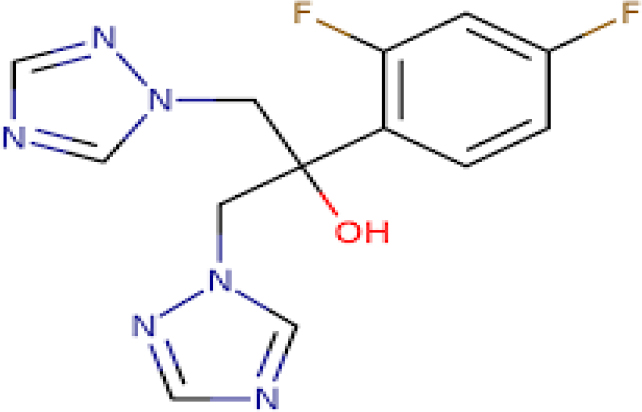
Figure 1:
Molecular structure of fluconazole.
The aim of this study, therefore, was to understand the effect of temperature and moisture on the polymorphic transformation of the antifungal model drug fluconazole. Fluconazole polymorphs were prepared by the single solvent crystallization method, and the impacts of time-triggered and temperature-triggered polymorphic transformation were investigated. The fluconazole polymorphs were characterized by FTIR, DSC, and XRPD methods and equilibrium solubility studies to illustrate the crystal transformation.
MATERIALS AND METHODS
Materials
Fluconazole was a gift sample provided by on top Pharmaceuticals (Bengaluru, India). Methanol was procured from Thermo Fischer Scientific (Mumbai, India). Acetone was procured from Karnataka Fine Chemicals (Bangalore, India). Isopropyl alcohol was procured from SD Fine Chem Limited (Bangalore, India). All other reagents and chemicals used in the study were of analytical grade.
Preparation of polymorphs
The single solvent crystallization method with the rotary evaporation technique was adopted to prepare the fluconazole polymorphs. Methanol, acetone, and isopropyl alcohol were used as recrystallizing solvents (Park et al., 2018). These solvents were redistilled prior to their use in order to ensure their purity. An excess amount of the compound was added to 50 mL solvent and agitated for 24 hr. The undissolved drug was filtered off, and the saturated solution was transferred to a rotary evaporator (Buchi, Sigma-Aldrich Pvt. Ltd.,) to remove the solvent. The vacuum and operating bath temperature during rotary evaporation were adjusted (Table 1) based on the solvent used in the crystallization process. The revolution speed of the RB flask was set to 120 rpm. The rotary evaporation process yielded dried crystals of fluconazole, which were collected and stored in a well-closed container away from light and moisture until analysis.
| Solvent used | Pressure (mbar) | Temperature of water bath (°C) | Revolution speed of RB flask | Fluconazole Polymorph |
|---|---|---|---|---|
| Methanol | 200 ±5 | 30 ± 2 | 120 | I |
| IPA | 150 ±5 | 40 ± 2 | 120 | II |
| Acetone | 370 ±5 | 30 ± 2 | 120 | III |
CHARACTERIZATION OF POLYMORPHS
Melting point determination
The melting points of a commercial sample of fluconazole and the crystals of fluconazole were determined by the Thiele tube method. The melting point of the crystals was detected as soon as they were obtained from the crystallization process.
Equilibrium solubility analysis
An excess amount of each polymorph was added to 10 mL distilled water in sealed containers. These samples were subjected to agitation at a speed of 50 rpm on a gyratory shaker under subdued light conditions at 28°C for 72 hr (Yadavet al., 2022). The solutions were then filtered through a dialysis membrane (Millipore filter, 0.45 µm), diluted as required, and applied to a UV spectrophotometer for quantitative analysis. The solubility of the polymorphs was determined using a calibration curve developed using a UV-visible spectrophotometer at 261 nm. The calibration curve was a function of the concentration and the absorbance, having a slope value of Y=0.048x+0.012 and a regression coefficient of r2 = 0.997.
Microscopic visual analysis
A Leica DM 1000 binocular microscope (Bloomington, IN, USA) was employed for microscopic visual analysis of the prepared polymorphs. Three magnifications of 40X, 100X, and 400X were used to study the peripheral structure of the polymorphs.
FTIR analysis
Differential Scanning Calorimetry (DSC) analysis
DSC thermal curves of fluconazole samples were obtained using a METTLER TOLEDO differential scanning calorimeter (Columbus, OH, USA). Accurately weighed samples (4-6mg) were placed in hermetically sealed aluminum crucibles (40 μL). The samples were heated and scanned in the range of 20 to 200°C at a heating rate of 5°C.min-1 under a dry nitrogen atmosphere (flow rate: 80 mL/min). Heat flow versus temperature plots were created to obtain the spectra (Gopalakrishnaet al., 2023).
XRPD analysis
The X-ray diffraction patterns of different samples were recorded using a wide-range X-ray diffractometer (SCINTAG XRD 3000, Houghton, MI, USA). The wavelength used was 1.5418Å (Cu radiation). The crystallographic information (d-spacing, % intensity) of commercially available fluconazole and the polymorphic crystals was calculated from the diffraction pattern using the following formula (Vishwaet al., 2021).
nλ = 2d sin Ө=where, n is the order of reflection; d is the inter-planar spacing between planes, which makes an angle of θ with incident beam; and λ is the wavelength.
Metastability Assessment
Impact of moisture on polymorphic transformation
The impact of moisture on polymorphic transformation was assessed by exposing the crystals to ambient conditions of 65 ± 5% RH and 28 ± 2°C for 40 days. The study was conducted and evaluated from the first day to the day on which initiation of transformation was noticed (Desai & Dharwadkar, 2009). The FTIR spectra and melting points of the samples were recorded on a daily basis. The results were monitored daily and compared to understand the occurrence of polymorphic transformation.
Impact of temperature on polymorphic transformation
To verify the impact of temperature on polymorphic transformation, the polymorphs were exposed to various temperatures (30°C, 40°C, 50°C, 60°C, 70°C, 80°C, 90°C, and 100°C) for 5 min each. The temperature was maintained using a thermostat-controlled water bath. Samples were analyzed with FTIR studies and melting point measurements. The temperature at which the transformation was initiated was recorded.
RESULTS
Microscopic analysis
The results of the microscopic analysis are shown in Figure 2. The commercial sample of fluconazole was found to be amorphous under microscopic observation. On the other hand, the Polymorph-I, obtained from methanol were translucent, with an irregular cuboid-like appearance; the Polymorph-II, prepared in acetone were translucent and long, with thin, blunt edges and clear striations on the surface, and occurred in clusters; and the Polymorph-III, prepared from isopropyl alcohol were transparent, long, thin-needle-like with blunt ends, and very fine in appearance.
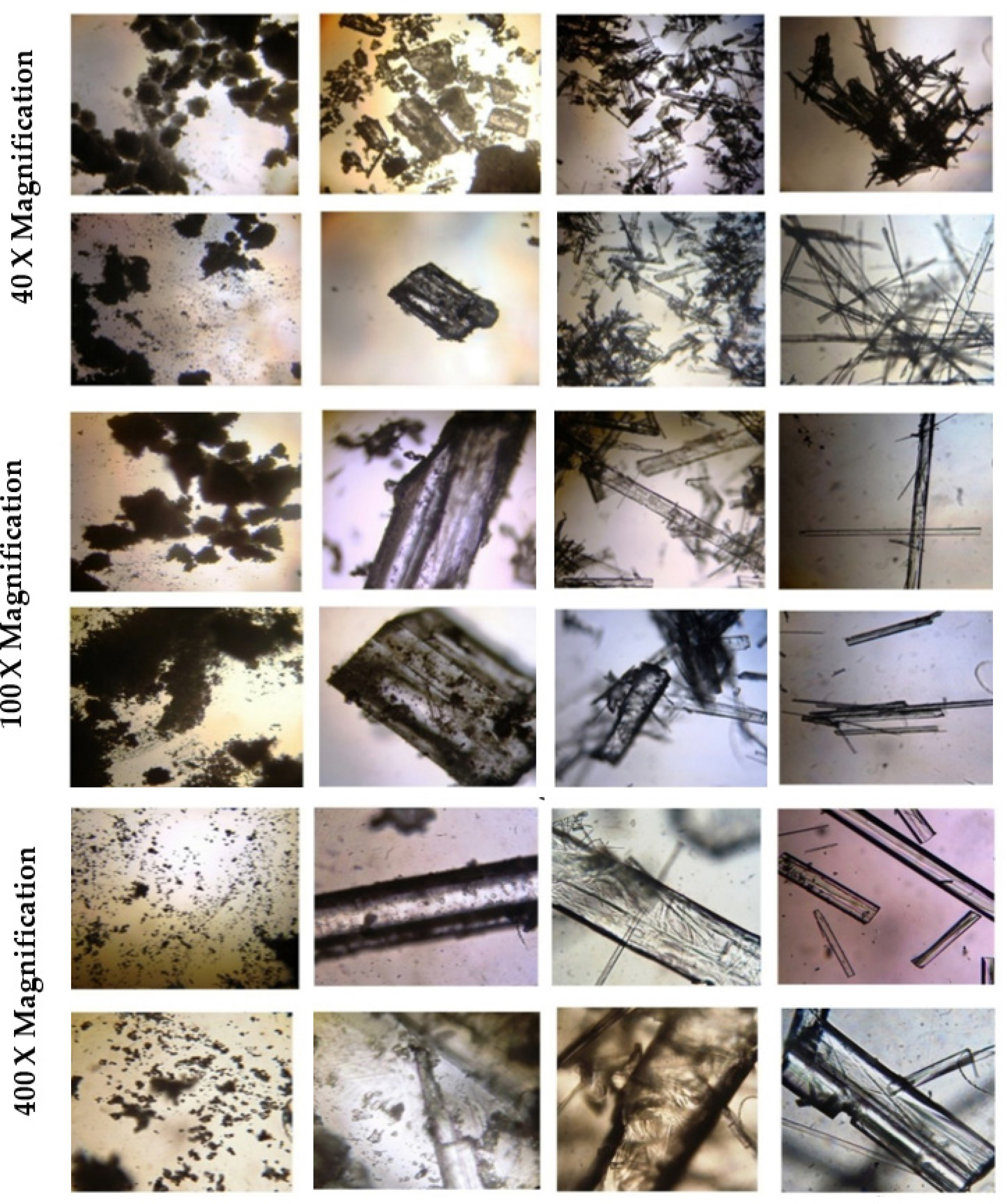
Figure 2:
Microscopic pictures at 40X, 100X, and 400X magnification for fluconazole: (A) commercial sample, (B) crystal prepared in methanol, (C) crystal prepared in acetone, and (D) crystal prepared in isopropyl alcohol.
Melting point and equilibrium solubility analysis
The commercial fluconazole sample was found to melt at 140 ± 2°C, and its solubility in distilled water was 7.8653 mg/mL. On the other hand, the Polymorph-I, II, and III obtained from methanol, acetone, and isopropyl alcohol respectively, were found to melt at 130 ± 5°C and had a solubility of 7.2211, 4.4211, and 4.9095 mg/mL in distilled water, respectively.
DSC analysis
The DSC thermal curves of the commercial sample and all polymorphs are depicted in Figure 3, and endothermic details are summarized in Table 2. The DSC thermal curves of the commercial sample show a prominent endotherm at 139.02°C with no additional peak (Figure 3). The polymorphic crystals showed additional peaks along with their distinctive endothermic peaks. Prominent spectral peaks for the Polymorph-I, II, and III were seen at 140.19°C, 139.91°C, and 139.03°C, respectively. Additional peaks for the Polymorphs-I and II were noticed at 102.61°C and 101.73°C, respectively, and a merging peak was noticed for the polymorph-III (Figure 3).
| Details | Temperature (°C) | |||
|---|---|---|---|---|
| Amorphous fluconazole | Polymorph I | Polymorph II | Polymorph III | |
| Enthalpy (J/g) | 70.29 | 5.42, 121.90 | 117.75 | 10.05, 117.97 |
| Tonset (°C) | 137.69 | 100.74, 137.34 | 138.34 | 99.95, 137.72 |
| Tpeak (°C) | 139.02 | 102.61, 140.19 | 139.91 | 101.73, 139.03 |
| Tendset (°C) | 141.85 | 104.72, 143.09 | 142.53 | 104.21, 142.04 |
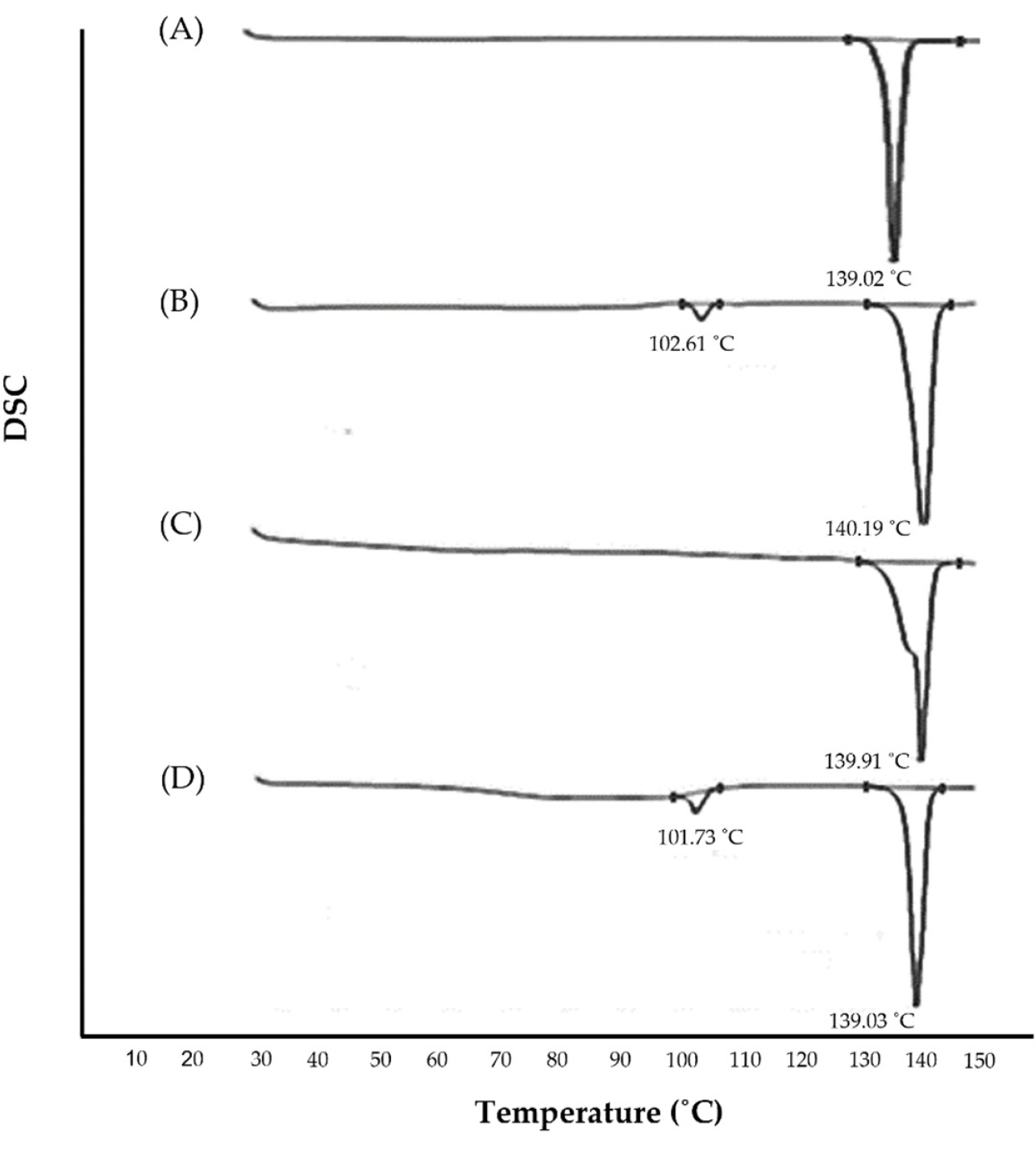
Figure 3:
DSC thermograms of fluconazole: (A)Amorphous fluconazole, (B) Polymorph I, (C) Polymorph II, and (D) Polymorph III.
XRPD analysis
The X-ray powder diffraction patterns obtained for different crystals are shown in Figure 4. The diffractograms of the commercial sample and all the polymorphic crystals were different in their spectral patterns. The position and intensity of the maximum intensity peaks were distinctively diverse for each sample (Table 3), confirming the formation of three different polymorphs upon recrystallization from different solvents.
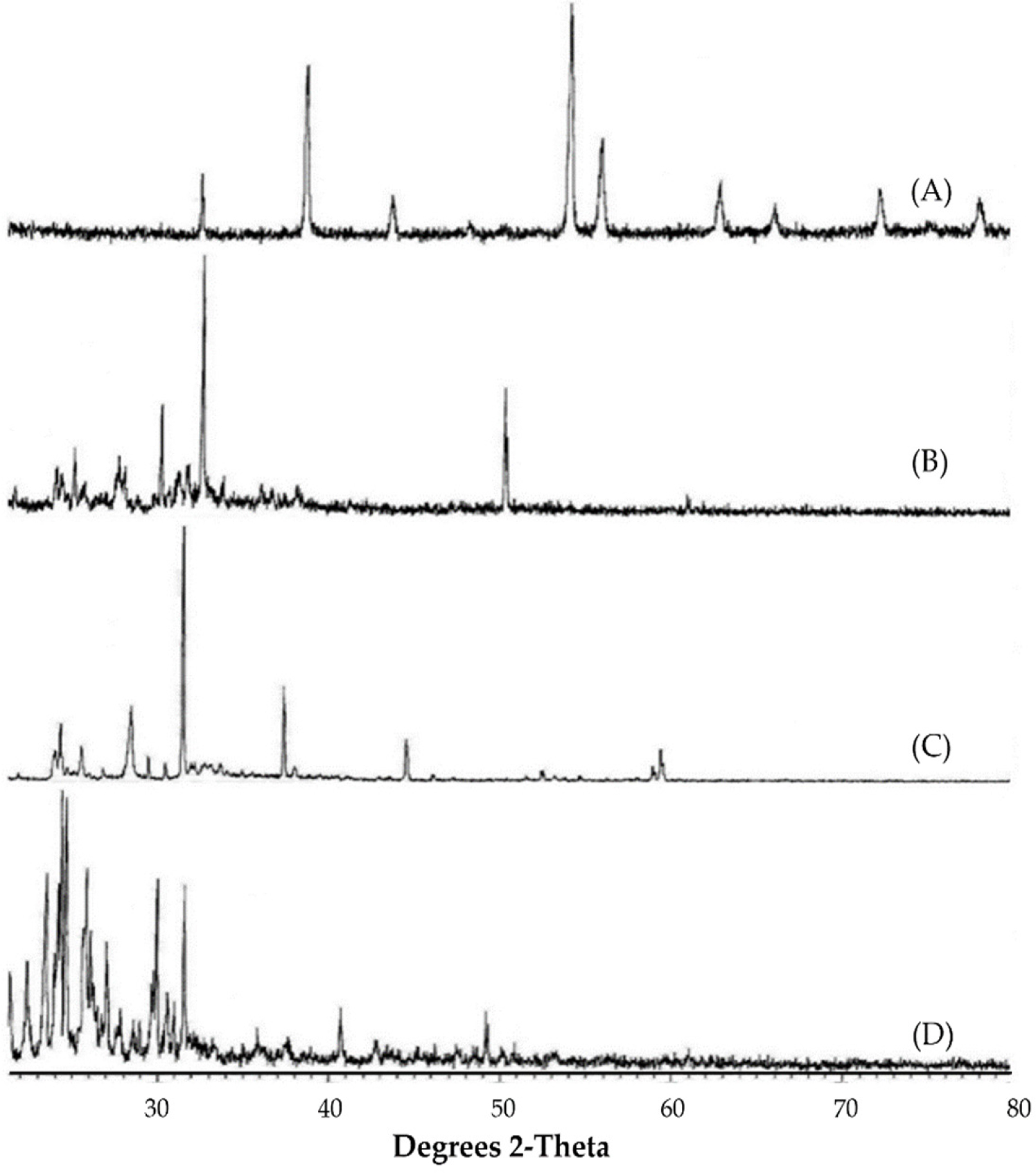
Figure 4:
XRPD patterns of fluconazole: (A) Polymorph I, (B) Polymorph II, (C) Polymorph III, and (D) Amorphous form.
| Vibrations | Wavenumber (cm-a) | ||
|---|---|---|---|
| Polymorph I | |||
| Day 1 | Time-triggered (Day 29) | Temperature-triggered (80°C) | |
| O–H (stretching) | 3250 | No changes | Peak shift towards 3100 |
| Aromatic C–H (stretching) | 3090 | Peak shift towards 3050 | Peak shift towards 3050 |
| Aliphatic C–H (stretching) | 2970 | No changes | No changes |
| C=N (stretching) | 1660 | Peak shift towards 1600 | Peak shift towards 1580 |
| –ea2 (stretching) | 1456 | No changes | No changes |
| C–F (stretching) | 1230 | No changes | No changes |
| 1,2,4 trisubstituted aromatic ring | 890 | No changes | No changes |
| C–O (stretching) | 1130 | No changes | No changes |
| Polymorph II | |||
| Day 1 | Time-triggered (Day 19) | Temperature-triggered (90°C) | |
| O–H (stretching) | 3250 | Peak shift towards 3100 | Peak shift towards 3100 |
| Aromatic C–H (stretching) | 3090 | No changes | No changes |
| Aliphatic C–H (stretching) | 2970 | No changes | No changes |
| C=N (stretching) | 1660 | Peak shift towards 1600 | Peak shift towards 1600 |
| –ea2 (stretching) | 1456 | No changes | No changes |
| C–F (stretching) | 1230 | No changes | No changes |
| 1,2,4 trisubstituted aromatic ring | 890 | No changes | No changes |
| C–O (stretching) | 1130 | No changes | No changes |
| Polymorph III | |||
| Day 1 | Time-triggered (Day 10) | Temperature-triggered (80°C) | |
| O–H (stretching) | 3250 | Peak shift towards 3100 | Peak shift towards 3100 |
| Aromatic C–H (stretching) | 3090 | No changes | No changes |
| Aliphatic C–H (stretching) | 2970 | No changes | No changes |
| C=N (stretching) | 1660 | Peak shift towards 1600 | Peak shift towards 1600 |
| –ea2 (stretching) | 1456 | No changes | No changes |
| C–F (stretching) | 1230 | No changes | No changes |
| 1,2,4 trisubstituted aromatic ring | 890 | No changes | No changes |
| C–O (stretching) | 1130 | No changes | No changes |
FTIR analysis
The results of FTIR analysis are shown in Figure 5. Amorphous fluconazole showed the presence of aliphatic and aromatic C-H stretching at 2970 cm–h and 3090 cm–a, respectively. The C-O stretching band was observed at 1130 cm–. Similarly, recrystallized fluconazole showed the presence of aliphatic and aromatic C-H stretching at 2970 cm– and 3090 cm–a, respectively. The 1, 2, 4 trisubstituted aromatic ring, C-F stretching, and C=N stretching were observed at 890 cm-a, 1230 cm-1, and 1660 cm–, respectively, for the both amorphous fluconazole and the crystals as well.
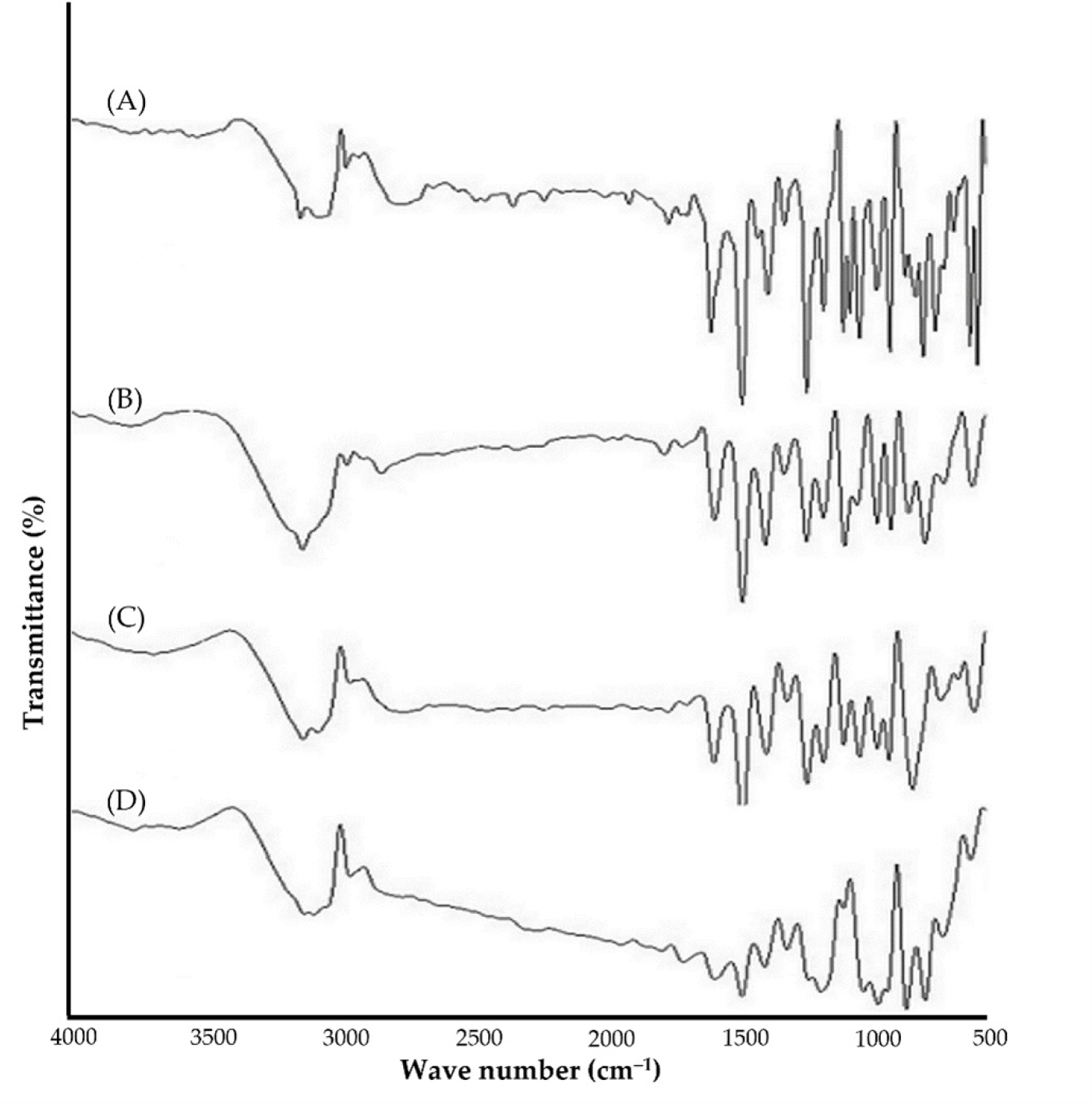
Figure 5:
FTIR spectra of fluconazole: (A) Amorphous Fluconazole, (B) Polymorph I, (C) Polymorph II, and (D) Polymorph III.
Metastability Assessment
Impact of moisture on polymorphic transformation
Analysis of the Polymorph-I showed a shift of the C-H stretch peak from 3090 to 3050 cm–I and the C=N stretching peak from 1660 to 1600 cm-a (Table 4 and Figure 6A), and a melting point shift to 138 ± 2°C on 29th day. Similarly, the analysis of polymorph-II showed a shift of O-H stretching from 3250 to 3100 cm-d and a shift of C=N stretching peak from 1660 to 1600 cm-anon 10th day (Table 4 and Figure 6A). A shift in the melting point to 138 ± 2°C was also observed. For the polymorph-III, a shift of the O-H stretching peak from 3250 to 3100 cm-n and of the C=N stretching peak from 1660 to 1600 cm-a (Table 4 and Figure 7A), as well as a shift in the melting point from 110°C to 120 ± 2°C was observed on 19th day.
| 2θ values | Polymorph I | Polymorph II | Polymorph III | Amorphous form | ||||
|---|---|---|---|---|---|---|---|---|
| d (Å) | % I | d (Å) | % I | d (Å) | % I | d (Å) | % I | |
| 14.5 | – | – | 6.11 | 21.19 | 6.11 | 22.53 | 4.15 | 36.25 |
| 15 | – | – | 5.9 | 18.16 | – | – | 3.95 | 40.35 |
| 15.9 | – | – | 5.57 | 28 | – | – | 3.78 | 71.13 |
| 19 | – | – | 4.67 | 24.98 | 4.67 | 30.04 | 3.64 | 100 |
| 21.9 | – | – | 4.05 | 45.42 | – | – | 3.59 | 97.81 |
| 22.5 | – | – | – | – | 5.8 | 18.14 | 3.45 | 72.5 |
| 23.5 | – | – | – | – | 3.1 | 37.55 | 3.29 | 46.51 |
| 24.51 | – | – | – | – | – | – | 2.97 | 68.4 |
| 24.8 | – | – | – | – | – | – | 6.11 | 21.19 |
| 25.8 | – | – | – | – | 5.57 | 28 | 5.5 | 17.16 |
| 27.1 | 2.39 | 22.48 | 1.76 | 45.73 | 2.39 | 17.27 | 2.81 | 66.34 |
| 28.8 | – | – | – | – | – | – | – | – |
| 30 | 6.21 | 22.15 | 3.59 | 100 | – | – | – | – |
| 31.82 | – | – | – | – | 3.95 | 100 | 2.21 | 23.25 |
| 37.58 | 2.81 | 74.41 | – | – | 1.76 | 45.73 | – | – |
| 40.8 | – | – | – | – | – | – | 1.85 | 21.88 |
| 45.5 | 1.76 | 45.73 | – | – | 1.74 | 13.51 | ||
| 49.86 | – | – | – | – | – | – | 5.5 | 16.13 |
| 51.89 | 1.54 | 29.45 | 1.99 | 51.44 | – | – | – | – |
| 52.6 | 1.82 | 100 | – | – | – | – | – | – |
| 60 | – | – | – | – | 4.63 | 24.87 | – | – |
| 63.98 | 1.32 | 25.57 | – | – | – | – | – | – |
| 71.12 | – | – | – | – | – | – | – | – |
| 77.61 | 1.23 | 21.7 | – | – | – | – | – | – |
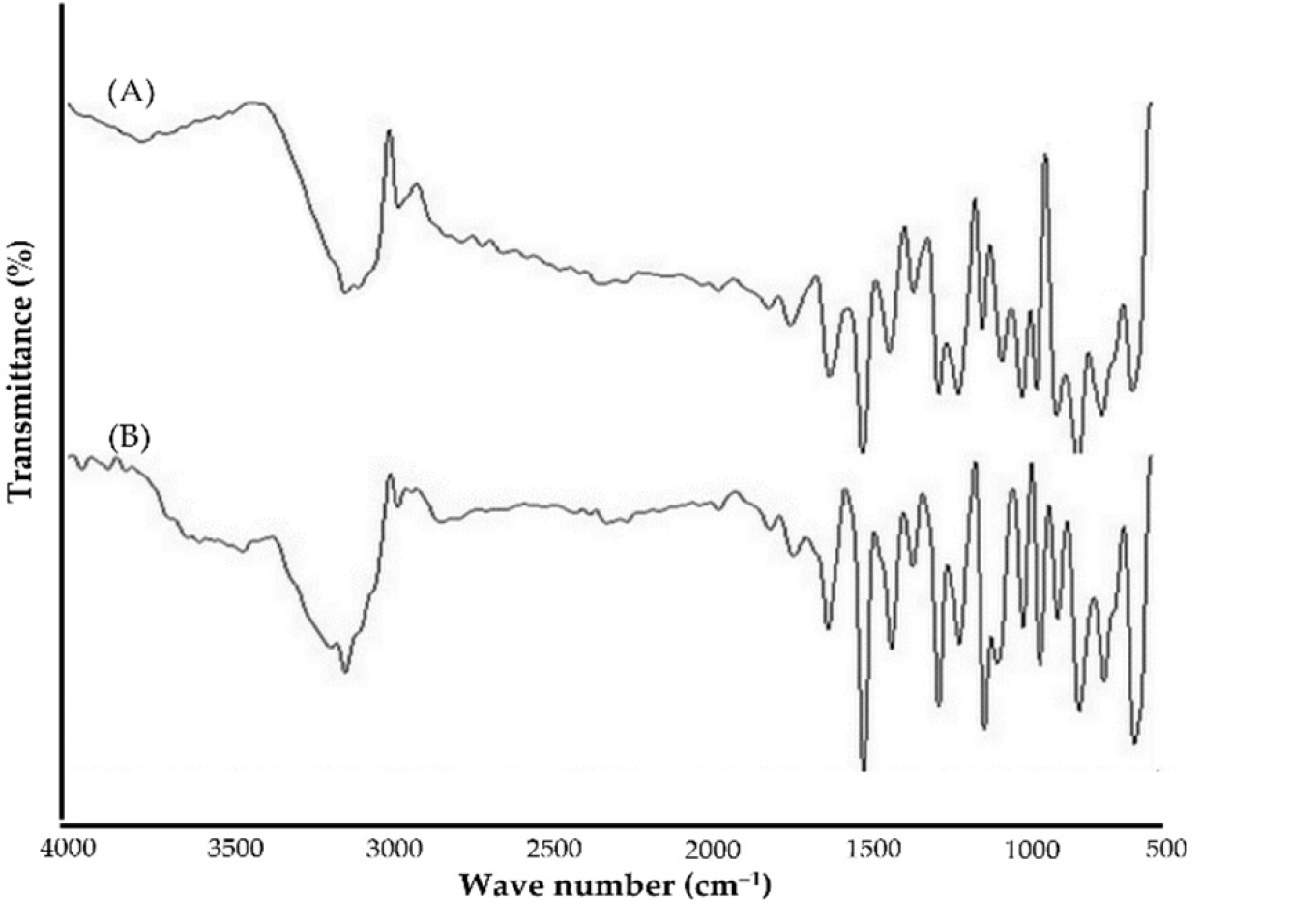
Figure 6:
FTIR spectra of fluconazole Polymorph II, (A) Time-triggered and (B) temperature-triggered assessment
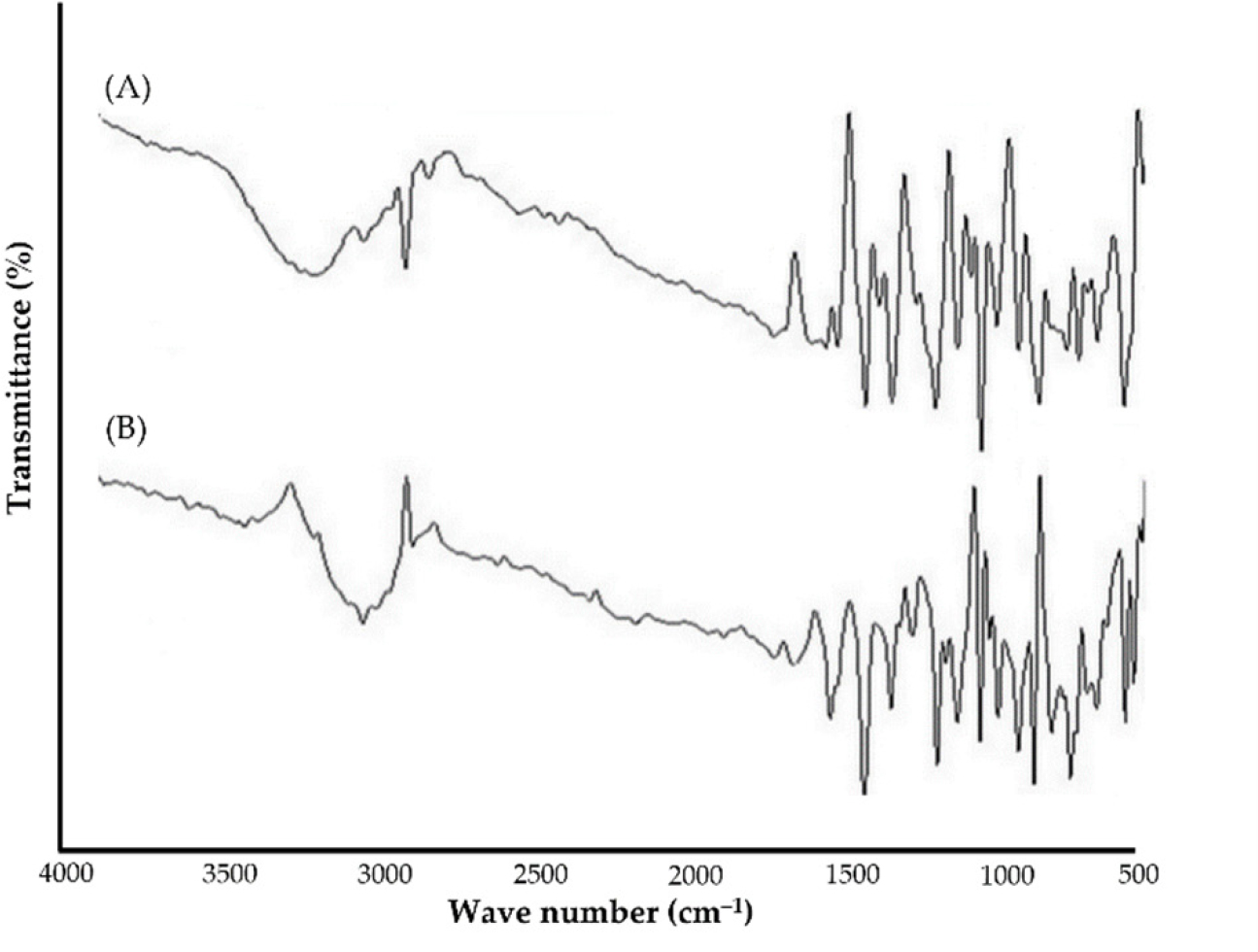
Figure 7:
FTIR spectra of fluconazole Polymorph III, (A) Time-triggered and (B) temperature-triggered assessment.
Temperature-triggered polymorphic transformation
The Polymorph-I showed changes in its FTIR pattern when maintained at 80°C in an undisturbed condition. The -OH stretching band shifted from 3250 to 3100 cm-h, the aromatic C-H stretching band shifted from 3090 to 3050 cm–, and the C=N stretching band shifted from 1660 to 1580 cm– (Figure 8B, Table 4). Similarly, for the Polymorph-II, changes in the crystal pattern were initiated at 80˚C, as manifested by the shift of the -OH broad peak from 3250 to 3100 cm-S and of the C=N stretching peak from 1660 to 1600 cm-an (Figure 7B, Table 4). The Polymorph-III showed transformation at 90°C, where, the broad –OH peak shifted from 3250 to 3100 cm-r and the C=N stretching peak shifted from 1660 to 1600 cm-1 (Figure 7B, Table 4).
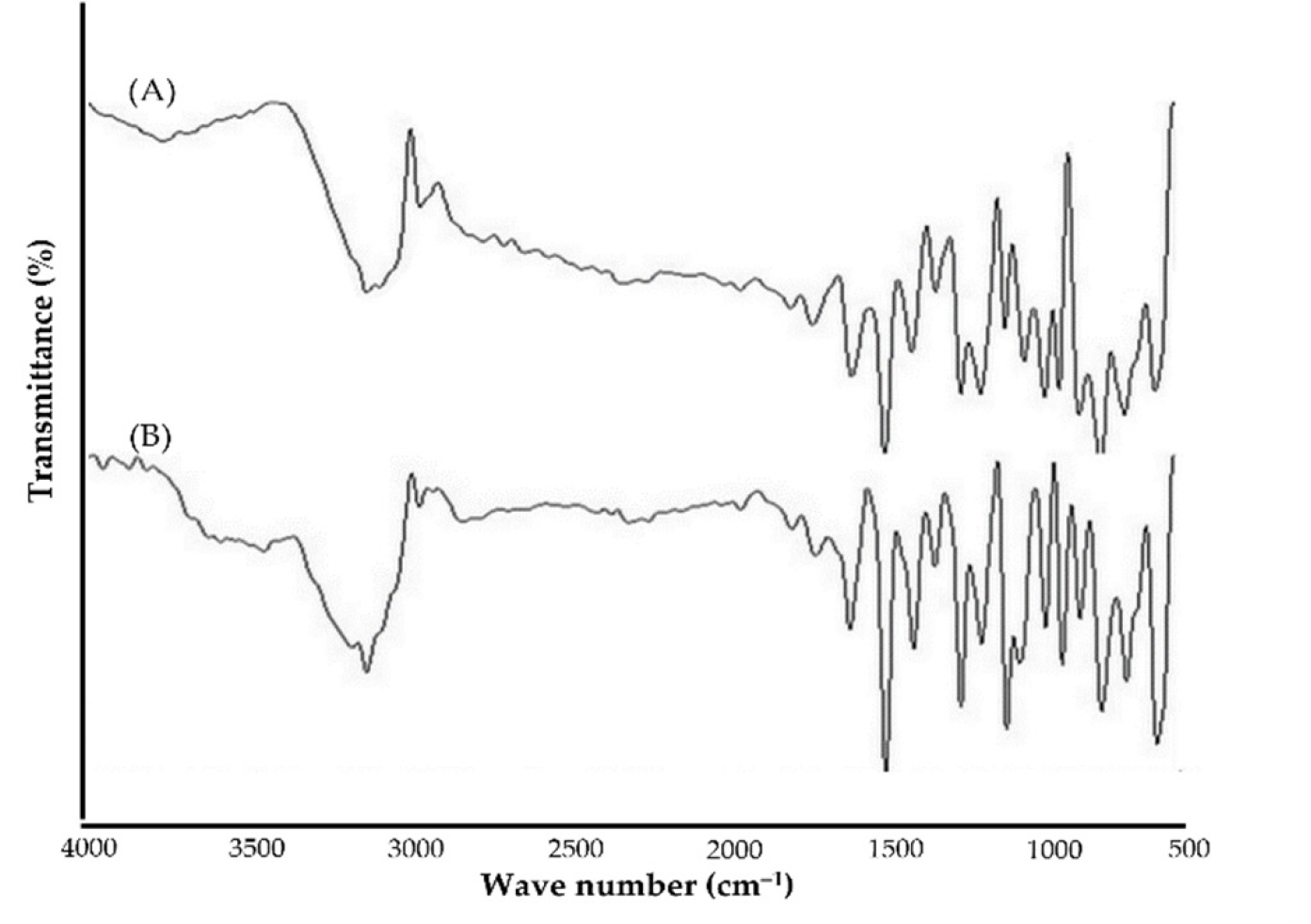
Figure 8:
FTIR spectra of fluconazole Polymorph I, (A) Time-triggered and (B) temperature-triggered assessment.
DISCUSSION
Microscopic analysis was initially employed to qualitatively assess polymorphic behavior (Hoet al., 2012). As shown in Figure 2, the commercial fluconazole sample was amorphous, whereas different solvents yielded distinct polymorphic forms. Crystallization from methanol produced a translucent, irregular cuboid-like structure designated as Polymorph-I. Acetone crystallization resulted in a long, translucent crystal with thin, blunt edges and striations on the surface, identified as Polymorph-II. Meanwhile, crystallization from isopropyl alcohol generated transparent, long, thin needle-like crystals with blunt ends, classified as Polymorph-III. These observations align with the literature where the impact of solvent on ibuprofen crystal formation was studied (Rasenack & Müller, 2002).
Fluconazole polymorphs exhibited distinct crystal forms with variations in molecular lattice arrangements, influencing their melting points, solubilities, and optical characteristics (Pudipeddi & Serajuddin, 2005). Crystalline materials with high melting points and large enthalpies of fusion are typically less soluble than those with lower melting points (Martin & Carstensen, 1981). Strong crystal lattices favor crystallization in solvents, reducing solubility (Nyman & Day, 2016). Conversely, weak lattices resist crystallization, resulting in higher solute concentrations. Microscopic analysis confirmed that recrystallized fluconazole formed needle-like structures (Figure 2), exhibiting a highly crystalline state with greater heat of fusion, as evident in DSC results. Consequently, these forms demonstrated higher stability and lower solubility. In contrast, the commercial sample displayed lower crystallinity and heat of fusion, rendering it more soluble and closer to an amorphous state.
DSC study distinguishes polymorphic forms due to the correlation between crystal modification and melting point, corroborating literature values (Corrêa & Salgado, 2011). The emergence of additional peaks and merging transitions in Polymorph-I, II, and III suggests polymorphic transformations. Extra peaks in Polymorph-I and III indicate the presence of metastable crystals, implying an ongoing transformation process. In contrast, the merging peak in Polymorph-II’s thermal curve suggests an impending transition from crystalline to amorphous form. These findings highlight temperature’s significant role in crystal transformation during DSC analysis.
Reaction enthalpy measurements further validated these differences. The commercial fluconazole had a reaction enthalpy of 70.29 J/g, whereas Polymorph-I, II, and III exhibited significantly higher values of 121.9, 117.75, and 117.97 J/g, respectively. The increased energy requirement for crystalline forms is attributed to the stronger bonds within the crystal lattice. Conversely, the amorphous form’s irregular molecular arrangement results in a lower reaction enthalpy.
When analyzed with XRPD, the recrystallized fluconazole exhibited high-intensity, sharp peaks, confirming its crystallinity due to the periodic atomic arrangement in three-dimensional space. In contrast, the commercial fluconazole sample produced broad, diffuse peaks, indicating a lack of long-range atomic order and confirming its amorphous nature (Figure 4).
Fourier Transform Infrared Spectroscopy (FTIR) further characterized the polymorphs. The FTIR spectra of amorphous fluconazole and recrystallized polymorphs (I, II, and III) displayed distinct spectral differences (Figure 5), consistent with prior studies (Alaoui Mansouriet al., 2021). The recrystallized fluconazole exhibited characteristic peaks corresponding to aliphatic and aromatic groups, similar to the amorphous form, suggesting isomerism (Bolaji et al., 2019).
The stability of fluconazole polymorphs evaluated over 40 days at 65 ± 5% RH and 28 ± 2°C through melting point and FTIR analyses indicated significant shifts in crystal transformation. For Polymorph-I, transformation began on the 29th day, marked by a shift in the C-H stretch peak from 3090 to 3050 cm–¹ and the C=N stretching peak from 1660 to 1600 cm–¹, alongside a melting point increase to 138 ± 2°C. Polymorph-II exhibited transformation as early as day 10, evidenced by an O-H stretching peak shift from 3250 to 3100 cm–¹ and a C=N peak shift from 1660 to 1600 cm–¹, with a melting point increase to 138 ± 2°C. Polymorph-III transformation was detected by day 19, indicated by an O-H stretching peak shift from 3250 to 3100 cm–¹ and a C=N peak shift from 1660 to 1600 cm–¹, accompanied by a melting point rise from 110°C to 120 ± 2°C. These transformations underscore moisture’s role in inducing crystal changes.
The temperature-dependent polymorphic transformation of fluconazole was further analyzed. FTIR spectra revealed that transformation onset varied among polymorphs, influenced by the crystallization solvent. Significant FTIR spectral shifts confirmed Polymorph-I transformation at 80°C, with the O-H stretching peak shifting from 3250 to 3100 cm–¹, the aromatic C-H stretch from 3090 to 3050 cm–¹, and the C=N stretch from 1660 to 1580 cm–¹ (Figure 8B, Table 4). Similarly, Polymorph-II exhibited transformation at 80°C, with the O-H peak shifting from 3250 to 3100 cm–¹ and the C=N peak from 1660 to 1600 cm–¹ (Figure 7B, Table 4). Polymorph-III transformation occurred at 90°C, marked by similar peak shifts (Figure 7B, Table 4). These findings confirm that polymorphic transformations were initiated during DSC analysis, explaining additional peaks in Polymorph-I and III (Desaiet al., 2003). Collectively, metastability assessments demonstrate that both moisture and temperature significantly influence the polymorphic transformation of fluconazole recrystallized from different solvents.
CONCLUSION
In this study, we clearly underscored the impact of both temperature and humidity on polymorphic transformations of fluconazole. Crystal transformation was clearly evidenced via XRPD, DSC, and FTIR studies. Fluconazole Polymorph-I (crystals prepared in methanol) and Polymorph-II (crystal prepared in acetone) showed crystal transformation at 80°C, while Polymorph-III (crystal prepared in isopropyl alcohol) exhibited crystal transformation at 90°C. In addition, an impact of moisture on crystal transformation was observed on the 10th, 29th, and 19th days for Polymorph-I, II and III, respectively, upon storage at 65 ± 5% RH/28 ± 2°C, as evidenced by remarkable changes in the melting points and FTIR spectra of the various crystals. Collectively, energetic steps involving heating of the drug and exposure to moisture will bring about polymorph transformation in fluconazole, which can dramatically affect the drug solubility and, hence, its biological performance.
Cite this article:
Moin A, Boregowda SS, Jayaramu RA, Prashanth VRSSP, Kudkuli S, Lila ASA. Solid-State Characterization of Fluconazole Polymorphs: Temperature and Time-Triggered Analysis. J Young Pharm. 2025;17(3):592-603.
ACKNOWLEDGEMENT
The authors are thankful to the Management, Acharya & BM Reddy College of Pharmacy, Bengaluru, India, KLE College of Pharmacy, Bengaluru-560010, KLE Academy of Higher Education and Research, Belagavi-590010, Karnataka, India, and University of Hail, Hail 81442, Saudi Arabia, for the research support and encouragement.
The authors are thankful to the Management, Acharya & BM Reddy College of Pharmacy, Bengaluru, India, KLE College of Pharmacy, Bengaluru-560010, KLE Academy of Higher Education and Research, Belagavi-590010, Karnataka, India, and University of Hail, Hail 81442, Saudi Arabia, for the research support and encouragement.
References
- Alaoui Mansouri M., Ziemons E., Sacré P.-Y., Kharbach M., Barra I., Cherrah Y., Hubert P., Marini R. D., Bouklouze A., et al. (2021) Classification of polymorphic forms of fluconazole in pharmaceuticals by FT-IR and FT-NIR spectroscopy. Journal of Pharmaceutical and Biomedical Analysis 196: Article 113922 https://doi.org/10.1016/j.jpba.2021.113922 | Google Scholar
- Alkhamis K. A., Obaidat A. A., Nuseirat A. F.. (2002) Solid-state characterization of fluconazole. Pharmaceutical Development and Technology 7: 491-503 https://doi.org/10.1081/pdt-120015052 | Google Scholar
- Baddley J. W., Patel M., Bhavnani S. M., Moser S. A., Andes D. R.. (2008) Association of fluconazole pharmacodynamics with mortality in patients with candidemia. Antimicrobial Agents and Chemotherapy 52: 3022-3028 https://doi.org/10.1128/AAC.00116-08 | Google Scholar
- Boyd B. J., Bergström C. A. S., Vinarov Z., Kuentz M., Brouwers J., Augustijns P., Brandl M., Bernkop-Schnürch A., Shrestha N., Préat V., Müllertz A., Bauer-Brandl A., Jannin V., et al. (2019) Successful oral delivery of poorly water-soluble drugs both depends on the intraluminal behavior of drugs and of appropriate advanced drug delivery systems. European Journal of Pharmaceutical Sciences: Official Journal of the European Federation for Pharmaceutical Sciences 137: Article 104967 https://doi.org/10.1016/j.ejps.2019.104967 | Google Scholar
- Corrêa J. C. R., Salgado H. R. N.. (2011) Review of fluconazole properties and analytical methods for its determination. Critical Reviews in Analytical Chemistry 41: 124-132 https://doi.org/10.1080/10408347.2011.557980 | Google Scholar
- Dayo Owoyemi B. C., Da Silva C. C. P., Souza M. S., Diniz L. F., Ellena J., Carneiro R. L., et al. (2019) Fluconazole: Synthesis and structural characterization of four new pharmaceutical cocrystal forms. Crystal Growth and Design 19: 648-657 https://doi.org/10.1021/acs.cgd.8b01194 | Google Scholar
- Desai S. R., Dharwadkar S. R.. (2009) Study of process induced polymorphic transformations in fluconazole drug. Acta Poloniae Pharmaceutica 66: 115-122 https://doi.org/10.1021/acs.cgd.8b01194 | Google Scholar
- Desai S. R., Shaikh M. M., Dharwadkar S. R.. (2003) Thermoanalytical study of polymorphic transformation in fluconazole drug. Thermochimica Acta 399: 81-89 https://doi.org/10.1016/S0040-6031(02)00451-3 | Google Scholar
- Gopalakrishna P. K., Jayaramu R. A., Boregowda S. S., Eshwar S., Suresh N. V., Abu Lila A. S., Moin A., Alotaibi H. F., Obaidullah A. J., Khafagy E.-S., et al. (2023) Piperine-loaded in situ gel: Formulation, in vitro characterization, and clinical evaluation against periodontitis. Gels 9: 577 https://doi.org/10.3390/gels9070577 | Google Scholar
- Guo Z., Ma M., Wang T., Chang D., Jiang T., Wang S., et al. (2011) A kinetic study of the polymorphic transformation of nimodipine and indomethacin during high shear granulation. AAPS PharmSciTech 12: 610-619 https://doi.org/10.1208/s12249-011-9628-8 | Google Scholar
- Ho R., Naderi M., Heng J. Y. Y., Williams D. R., Thielmann F., Bouza P., Keith A. R., Thiele G., Burnett D. J., et al. (2012) Effect of milling on particle shape and surface energy heterogeneity of needle-shaped crystals. Pharmaceutical Research 29: 2806-2816 https://doi.org/10.1007/s11095-012-0842-1 | Google Scholar
- Martin A., Carstensen J.. (1981) Extended solubility approach: Solubility parameters for crystalline solid compounds. Journal of Pharmaceutical Sciences 70: 170-172 https://doi.org/10.1002/jps.2600700214 | Google Scholar
- Moin A., Wani S. U.A D., Osmani R. A., Abu Lila A. S., Khafagy E. S., Arab H. H., Gangadharappa H. V., Allam A. N., et al. (2021) Formulation, characterization, and cellular toxicity assessment of tamoxifen-loaded silk fibroin nanoparticles in breast cancer. Drug delivery 28: 1626-1636 https://doi.org/10.1080/10717544.2021.1958106 | Google Scholar
- Nicoud L., Licordari F., Myerson A. S.. (2018) Estimation of the solubility of metastable polymorphs: A critical review. Crystal Growth and Design 18: 7228-7237 https://doi.org/10.1021/acs.cgd.8b01200 | Google Scholar
- Nyman J., Day G. M.. (2016) Modelling temperature-dependent properties of polymorphic organic molecular crystals. Physical Chemistry Chemical Physics: PCCP 18: 31132-31143 https://doi.org/10.1039/c6cp05447a | Google Scholar
- Park H. J., Kim M.-S., Kim J.-S., Cho W., Park J., Cha K.-H., Kang Y.-S., Hwang S.-J., et al. (2010) Solid-state carbon NMR characterization and investigation of intrinsic dissolution behavior of fluconazole polymorphs, anhydrate forms I and II. Chemical and Pharmaceutical Bulletin 58: 1243-1247 https://doi.org/10.1248/cpb.58.1243 | Google Scholar
- Park H. J., Kim M.-S., Lee S., Kim J.-S., Woo J.-S., Park J.-S., Hwang S.-J., et al. (2007) Recrystallization of fluconazole using the supercritical antisolvent (SAS) process. International Journal of Pharmaceutics 328: 152-160 https://doi.org/10.1016/j.ijpharm.2006.08.005 | Google Scholar
- Pudipeddi M., Serajuddin A. T. M.. (2005) Trends in solubility of polymorphs. Journal of Pharmaceutical Sciences 94: 929-939 https://doi.org/10.1002/jps.20302 | Google Scholar
- Rajamma A. J., Sateesha S. B., Narode M. K., Prashanth V. R., Karthik A. M.. (2015) Preparation and crystallographic analysis of gliclazide polymorphs. Indian Journal of Pharmaceutical Sciences 77: 34-40 https://doi.org/10.4103/0250-474x.151595 | Google Scholar
- Rasenack N., Müller B. W.. (2002) Properties of ibuprofen crystallized under various conditions: A comparative study. Drug Development and Industrial Pharmacy 28: 1077-1089 https://doi.org/10.1081/ddc-120014575 | Google Scholar
- Sathisaran I., Dalvi S. V.. (2018) Engineering cocrystals of poorly water-soluble drugs to enhance dissolution in aqueous medium. Pharmaceutics 10: 108 https://doi.org/10.3390/pharmaceutics10030108 | Google Scholar
- Thompson G. R., Cadena J., Patterson T. F.. (2009) Overview of antifungal agents. Clinics in Chest Medicine 30: Article 203-v https://doi.org/10.1016/j.ccm.2009.02.001 | Google Scholar
- Touil A., Peczalski R., Timoumi S., Zagrouba F.. (Array) Influence of air temperature and humidity on dehydration equilibria and kinetics of theophylline. Journal of Pharmaceutics : Article 892632 https://doi.org/10.1155/2013/892632 | Google Scholar
- Vasconcelos T., Marques S., das Neves J., Sarmento B.. (2016) Amorphous solid dispersions: Rational selection of a manufacturing process. Advanced Drug Delivery Reviews 100: 85-101 https://doi.org/10.1016/j.addr.2016.01.012 | Google Scholar
- Vishwa B., Moin A., Gowda D. V., Rizvi S. M. D., Hegazy W. A. H., Abu Lila A. S., Khafagy E.-S., Allam A. N., et al. (2021) Pulmonary targeting of inhalable moxifloxacin microspheres for effective management of tuberculosis. Pharmaceutics 13: 79 https://doi.org/10.3390/pharmaceutics13010079 | Google Scholar
- Yadav K., Sachan A. K., Kumar S., Dubey A.. (2022) Techniques for increasing solubility: A review of conventional and new strategies. Asian Journal of Pharmaceutical Research and Development 10: 144-153 https://doi.org/10.22270/ajprd.v10i2.1054 | Google Scholar
- Yoshinari T., Forbes R. T., York P., Kawashima Y.. (2002) Moisture induced polymorphic transition of mannitol and its morphological transformation. International Journal of Pharmaceutics 247: 69-77 https://doi.org/10.1016/s0378-5173(02)00380-0 | Google Scholar
- Zhou Y., Wang J., Xiao Y., Wang T., Huang X.. (2018) The effects of polymorphism on physicochemical properties and pharmacodynamics of solid drugs. Current Pharmaceutical Design 24: 2375-2382 https://doi.org/10.2174/1381612824666180515155425 | Google Scholar
